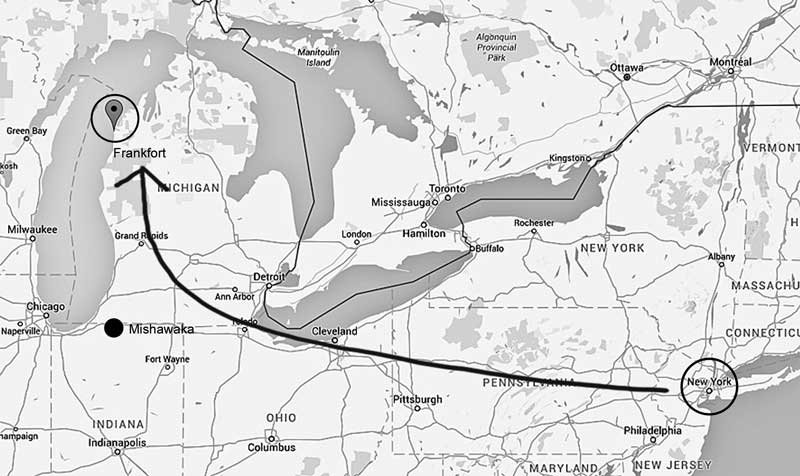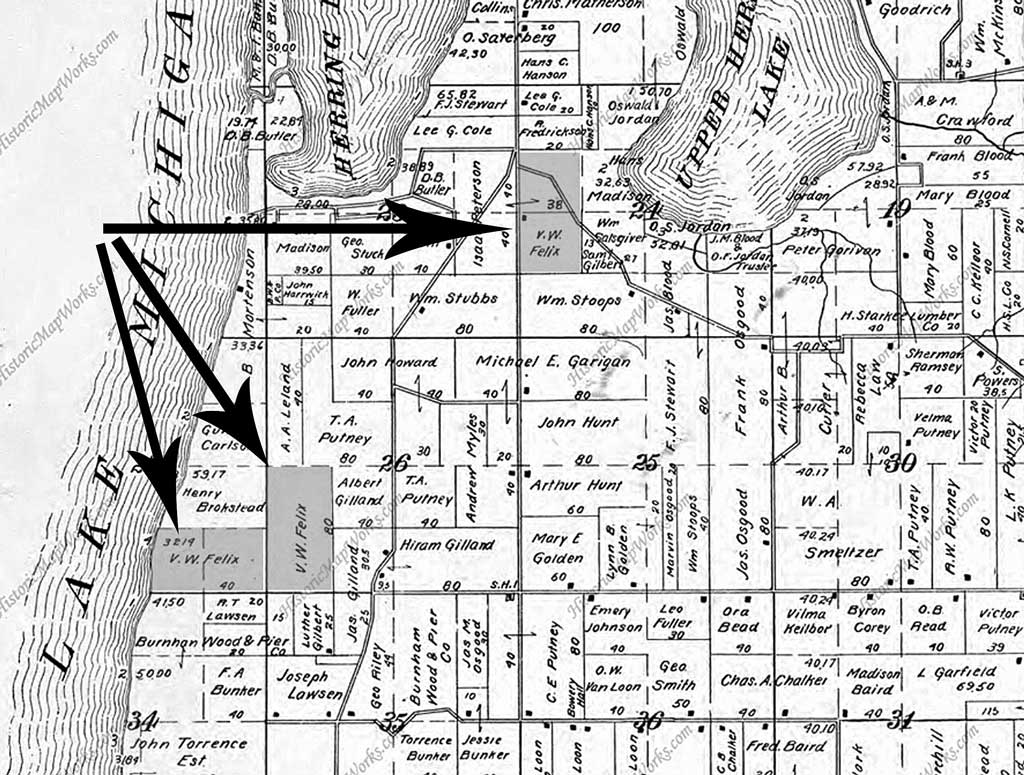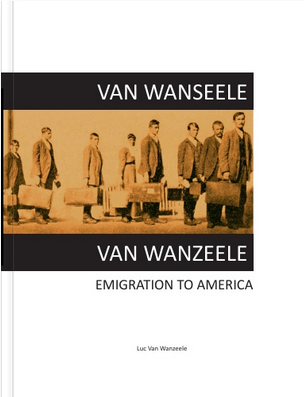Felix Van Wanseele
(1842-1917)
How did the émigrés from Nevele fare in the New World? Did their American Dream come true? We know little about ordinary people. We usually have to make do with general statistics. We do know a bit more about Felix Van Wanseele, from Nevele, and his life story is not unusual. There were thousands like him who set off for America in search of happiness and a better standard of life. Like most of his fellow travellers, he experienced both success and adversity.
Felix was born in Nevele on 25 July 1842. He was the fourth child from the marriage of Charles Louis Van Wanseele and Eugenia Berijngier, with whom he had five children. Father Charles was a countryman and lived in. The Zeistraat was known to its inhabitants as “Den Hul”. There, in a sort of reserve, lived poachers and crooks side by side in their lowly dwellings. Cyriel Buysse would later use it as inspiration for his book ‘Schoppenboer’ or ‘Shovel Farmer’:
“The Zijstraat was a really notorious neighbourhood of Brakel, widely known in the region for the licentiousness and degradedness of its inhabitants. There, within an indescribable mixture of sexes and relationships, in broken-down and disorderly slums, lived a population of beggars and thieves and wild brigands who were the scandal and terror of the district. The decent folk and honest farmers wanted absolutely nothing to do with that part of the village, where each Sunday saw terrible things occurring in the pubs, and where knife fights were commonplace; only a drunken farmer or landowner’s son would sometimes go there at night in search of wanton pleasure in drink or loose women.”
In 1866 Felix married Marie Theresia Vriendt in Nevele. He was 25 and a day laborer, she was three years older and a serving maid. It was a marriage “of necessity” as Marie Theresia was five months pregnant. To be unmarried and pregnant in those times was a scandal. Their daughter Marie Leonie was born on 26th January 1867.
Felix was an innkeeper at the time of the birth of his daughter. We shouldn’t make more of this than it was. In the same year the young family set off for America, something that in 1867 was not easy. The emigration movement only really began in 1880 or later. Emigration from Nevele peaked between 1900 and 1907.

We have no solid facts about their journey. Possibly it was still by sailing vessel as only from 1880 onwards would steam ships make the trans-Atlantic crossing. It is likely that their departure port was Antwerp but it could also have been Le Havre or Liverpool. Before the coming of the Red Star Line in 1872, Antwerp did not have a very good reputation due to all kinds of malpractices and the outdated ships with little provision for comfort. The Atlantic crossing by sailing ship took six to eight weeks but it could also be longer, no one knew beforehand. Steam ships would later take two weeks. They were also larger and had improved accommodation for passengers, which was a great advance.

The train journey from New York to their final destination of Crystal Lake Township, near Frankfort in northern Michigan, took another week. Crystal Lake as final destination was an unusual choice. In 1867 people in Hansbeke were more familiar with Mishawaka and South Bend (Indiana) as the Land of Promise. This lies four hundred km to the south of Frankfort. It is possible that Mishawaka or South Bend was their first idea and their final destination was altered on the way.
It was the time of the pioneers. The American War of Secession was just over and interest in the north of Michigan was great. The rush was spectacular and Crystal Lake Township, just above Frankfort, rose literally from the ground.
“In 1867 and 1868 the tide of settlers tended towards Northern Michigan and mechanics and artisans, traders and settlers, ex-soldiers and land speculators came pouring in from every quarter, and in such hurried confusion, and in such numbers that the mechanics and builders could not construct buildings or provide accommodations fast enough to meet the pressing demands of the hour. Not only was Frankfort being settled and built up, but the Government land throughout the county was being rapidly located and settled until, by 1869, it was difficult to find a forty acre lot in the county that was not pre-empted as a homestead or purchased for agricultural or speculative purposes. The succeeding years have been reasonably prosperous for the people of Frankfort and Crystal Lake township.”
Compared to Hansbeke in 1867, Crystal Lake Township was four times as large and the population density ten times lower. It number barely 120 houses. There were 127 families, a total of 586 inhabitants and almost all of them incomers from the south of Michigan and other American states. There were few immigrants from abroad, mainly Germans or Norwegians, with only seven Belgians: four single men and the Van Wanseele family. They worked as iron works laborers for the Frankfort Furnace Company.
“In 1869 the “Frankfort Furnace Company” (a corporation having its principal office in Detroit) had erected its smelting works in what is now South Frankfort, employing steam barges to bring iron ore from lake Superior region and carry away ‘pig iron’ the products from its smelting works, opened another avenue of communication to points not only on Lake Michigan, but to Detroit and Cleveland, Ohio, where a portion of said products was marketed.”
The registration of immigrants with their strange names was no easy task. The Van Wanseeles were no exception. Linguistically things often went wrong, so that we find Van Wanseele and Vanwanseele, Van Wansel, Van Wamsal, Van Wanzel and even Vanwangel. In the census of 1870 Marie Theresia became simply Mary. At the same address also lived the 22 year-old Belgian Eduard Goethals whose name was altered to Edward Gaathals. There was no trace of daughter Marie Leonie. Or perhaps there was, since there is reference to a three year old child: Leavie. A variation of Leonie, we assume. Leavie was also included as Leavie Gaathals instead of Leavie VanWanseele. This would be corrected in the following census when Marie Leonie became Mary L or even Leona Mary.
In contrast to other villages, people spoke very well of the immigrants in the region:
“We have a large number of foreign-born people in Gilmore; but unlike many other towns which claim to have had trouble with their foreign element, we have always got along well with them. As a rule they are honest, hard working, industrious people, who pay their debts and taxes.”
Felix’ housemate Eduard Goethals was even used as an example.
“Another unique character among us is in the person of Edward Goethals, more commonly known as Kaiser, who came to this country in 1869 and commenced working at the Furnace. He carried the first piece of pig iron that was taken from the Furnace to the dock. He says that working at the Furnace in those days was like working on the tower of Babel, as there were people from thirteen different nations at work there; and that he remembers working one day with seven men who were all of different nationalities and could not understand a word that each other said, but worked by signs. Mr. Goethals has filled various positions of trust in town, such as constable, township treasurer, district treasurer, overseer of highways, clerk for August Coddens, the Frankfort Lumber Company and Crane Lumber Company.”
Felix worked at the iron works for 15 years. In 1882 all activities ended when the furnace closed for good.
“The furnace commenced operations in July, 1870. It was supposed to turn out forty tons of iron every twenty-four hours and burn 15,000 cords of wood yearly, causing a disbursement of $45,000 annually. Mr. Crispen furnished the first wood. It run in good order until Mr. Fuller died when, under new management, it soon played out and was closed. The property has since passed into the hands of the Toledo & Ann Arbor railroad company and the old furnace building is used for a round house and machine shop, and the grounds for switches and a depot.”

By 1880 the Van Wanseele family had moved from Crystal Lake to nearby Gilmore, to the south of Frankfort. Felix was 38 and had begun to work as a farmer. The Fleming, John Van Eck also lived at the farm, probably as a farm laborer. He was the same age as Felix. We do not know what crops Felix cultivated but possibly it was fruit growing. We gather the following about Gilmore at the end of the 19th century:
“As to the geographical surface of Gilmore, we have hills and valleys, sand and water. The high lands are well adapted to fruit raising, and there are some fine peach orchards in town. Our means of transportation are very good, we being able to ship both by rail and boat. Gilmore has arrived at her present history without anything very exciting ever happening within her borders.”
For the period 1890 – 1900 we have no information except that the family had had four children before 1894, of whom only the oldest, Marie Leonie had survived. In 1900 Felix and his family moved again, this time to Joyfield, 15km south east of Gilmore. What did Joyfield look like at the end of the 19th century?
“ (…) in size it is four miles wide, east and west, and five miles long, north and south, and contains twenty sections of land. It is well watered by numerous spring brooks, the soil mostly a rich, sandy loam, is high and rolling and well adapted to farming and fruit raising; it contains some of the largest and finest farms and orchards in the county.(…) The vast forest that covered the township in 1863 has mostly disappeared, and in its place we see farms with large clearings, good buildings and fine orchards. Joyfield is destined to be one of the best, if not the best, township in the county.”

Felix was 58 and had in the meantime become a naturalised American citizen. In Joyfield he was a farmer. We don’t know what he grew but Joyfield was also known for its fruit crops.
Ten years later, (1910) Felix and his wife moved again, this time to Blaine on Lake Michigan, 7km west of Joyfield, again as a farmer. On the farm lived August Peterson, an American with Danish roots. He was likely a live-in farmhand, and at 72 was four years older than Felix. Blaine was their last place of residence. Felix finally became the owner of three pieces of farmland of 38, 40 and 80 acres; a total of 64 hectares of land. In East Flanders, 90% of the farms are smaller than 10 hectares. More than half of these are not even a half hectare. Not a bad ‘harvest’ for a farm worker from Nevele.
Felix died on 23 April 1917, at the age of almost 75. The cause of death was acute alcoholic gastritis, complicated with atrophic cirrhosis of the liver. Liver cirrhosis as a consequence of chronic alcohol abuse. It casts a shadow over his success as a farmer. In the same year, on 29 December, his wife Marie Theresia died from a chronic heart condition. She was 78.
In 1885 their only daughter Marie Leonie married Henry VanColen, who was six years older. He was Belgian by birth but not from Nevele. He only left for America in 1882, when he was 20. Five years later, in 1900, the young couple were living in Manistee alongside Lake Michigan about 45km from Blaine. Henry was a blacksmith. They had nine children. The first five were born in Manistee. In 1900 they moved to Blaine, near to Marie Leonie’s parents and also started a farm. Henry was then 51 and a naturalised American citizen, Marie Leonie was 43. Their four youngest children were born in Blaine. The eldest son, Felix, was 20 and worked with his father on the farm. Two years later he died. We don’t know the circumstances but it must have been a tragic event. In the same year as the death of her parents (1917) the couple divorced. Marie Leonie was 52 and remained alone on the farm with the five youngest children. Son Frank (25) was married and probably kept the farm going.
We know very little about the further adventures of the VanColen-VanWanseele family. Marie Leonie died at the age of 70, on 12 January 1938 in Blaine. She lived there for 28 years and never left. Her son Frank died 25 years later (1963) at the age of 69. In Blaine Township Cemetery today there is a gravestone that stands witness to a history that began in Nevele with Felix and Marie Theresia Van Wanseele and ends in Blaine (Michigan) with their daughter Marie Leonie Van Wanseele, in spite of her divorce, forever united with her husband Henry.

VAN WANSEELE and VAN WANZEELE
Emigration to America
Hard cover | 68 pages | black and white
Order at LULU.COM
